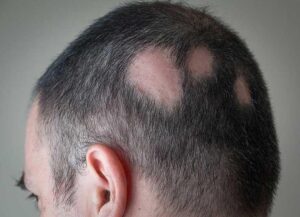Tinea Capitis (ringworm) – Causes, Symptoms & Treatment
1. What is Tinea Capitis?
Tinea capitis, commonly known as scalp ringworm, is a contagious fungal infection that affects the scalp and hair shafts. It can cause patchy hair loss, scalp scaling, and inflammation. This condition primarily affects children but can occur in adults as well.

2. Who is Most Commonly Affected?
- Children (especially between ages 3-10) are the most frequently affected. It is more common in African Americans.
- Individuals in close-contact environments, such as schools, daycare centers, and households.
- People with weakened immune systems are at higher risk.
- Those who share combs, hats, pillows, or other personal items can contract the infection.
3. What are the Symptoms?
- Round, scaly patches of hair loss on the scalp.
- Brittle or broken hairs near the scalp surface.
- Itching and redness of the affected areas.
- Black dots on the scalp where hairs have broken off.
- Painful, swollen areas (kerion), which may ooze pus in severe cases.

4. What Causes Tinea Capitis?
- Fungal Infection: Caused by dermatophyte fungi, such as Trichophyton or Microsporum species.
- Direct Contact: Spread through person-to-person contact, infected animals (cats, dogs), or contaminated objects.
- Warm, Humid Environments: Fungi thrive in moist conditions, increasing the risk of infection.
5. How is it Diagnosed?
- Clinical Examination: A dermatologist evaluates the scalp for characteristic signs.
- Wood’s Lamp Test: A special UV light can detect some types of fungi.
- Fungal Culture or Microscopy: A sample of hair or scalp skin is analyzed for fungal presence.
6. What are the Treatment Options?
- Oral Antifungal Medications (First-line Treatment):
- Griseofulvin – Traditionally used and highly effective.
- Terbinafine – A more modern alternative with a shorter treatment duration.
- Medicated Shampoos:
- Ketoconazole or Selenium Sulfide shampoos can help reduce fungal spread but not as the main treatment.
- Topical Antifungals: May help but are not sufficient alone for scalp infections.
- Proper Hygiene & Prevention:
- Regularly wash bedding, hats, and combs to prevent reinfection.
- Avoid sharing personal items.
- Treat household pets if they are suspected carriers.
7. Can Tinea Capitis Be Prevented?
- Practicing good scalp hygiene and avoiding close contact with infected individuals or animals can help reduce risk.
- Regular hair washing with antifungal shampoos may prevent recurrence.
- Early detection and treatment prevent complications such as scarring or secondary bacterial infections.
8. Frequently Asked Questions (FAQs)
- Is tinea capitis contagious? Yes, it spreads through direct and indirect contact.
- Can adults get tinea capitis? While more common in children, adults can also be affected.
- How long does treatment take? Oral antifungals typically require 4–8 weeks for full clearance.
- Does hair grow back after tinea capitis? Yes, hair generally regrows once the infection is treated, unless scarring has occurred.
9. When to See a Dermatologist
If you or your child experience scalp scaling, itching, hair loss, or redness, consult a dermatologist for diagnosis and treatment. Early treatment can prevent complications and stop the infection from spreading.
10. Next Steps & How to Get Treatment
If you suspect tinea capitis, schedule an appointment with our hair loss dermatologist for an evaluation and antifungal prescription. Proper treatment and prevention measures can ensure a full recovery and minimize recurrence.

